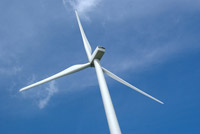 To ensure wind turbines that are big in size work in a better manner, a new kind of air-flow technology may soon be introduced. Apart from other aspects, it will focus on efficiency of blades used in the wind turbines. The technology will help in increasing the efficiency of these turbines under various wind conditions. This is a significant development in the area of renewable energy after new wind-turbine power generation capacity got added to new coal-fired power generation in 2008.
To ensure wind turbines that are big in size work in a better manner, a new kind of air-flow technology may soon be introduced. Apart from other aspects, it will focus on efficiency of blades used in the wind turbines. The technology will help in increasing the efficiency of these turbines under various wind conditions. This is a significant development in the area of renewable energy after new wind-turbine power generation capacity got added to new coal-fired power generation in 2008.
Testing new systems to optimize the efficiency of wind turbines and their blades
Syracuse University researchers Guannan Wang, Basman El Hadidi, Jakub Walczak, Mark Glauser and Hiroshi Higuchi are testing new intelligent-system based active control methods with the support from the U S Department of Energy through the University of Minnesota Wind Energy Consortium. They record data in an intelligent controller after getting a rough idea of the flow conditions over the blade surfaces from surface measurement. This helps them implement real-time actuation on the blades. In this way, not only the efficiency of wind turbine system is increased but the airflow can also be managed.
Advantages of new systems to optimize the efficiency of wind turbines and their blades
- They reduce noise.
- They reduce vibration.
New developments that are being worked out to make wind turbines and blades more efficient
- The overall working scope of the wind turbine can be enlarged by using the flow control on the outboard side of the blade beyond the half radius. Attempts are being made to increase the rated output power without increasing the level of operating range.
- An anechoic chamber is being set-up to measure and define the effects of flow control on the noise spectrum of the wind turbine.
- To know the airfoil lift and drag characteristics with suitable flow control while exposed to large-scale flow unsteadiness, efforts are being made to characterize airfoil in an anechoic wind tunnel facility at Syracuse University.
- Scientists are also trying to attain a greater efficiency by placing blades at various angles through wind tunnel tests of 2.5 megawatt turbine airfoil surfaces and computer simulations.
Drawbacks of wind energy turbines and their blades
The blades face a lot of challenge while beating the air. Scientists at the University of Minnesota are looking forward to erect this process called drag by placing these small grooves or triangular riblets scored into a coating on the surface of the turbine blade. The small groves of the size between 40 to 225 microns make the blade look smooth. When used in an aero plane, the riblets were very successful. With their basic structure being the same as the wings of the plane, they were able to reduce the drag by 6 percent in aircrafts. But since the turbine blades have a thick cross section close to the hub and there is a lot of chaos at the ground, this technology failed in wind turbines.
Anything working on wind energy including wind turbines needs a steady wind flow to function properly. The wind turbine blades, when confronted with extreme conditions, wear out very fast.
The design of wind turbines is not considered appropriate, despite the fact that the cost of making power through them has reduced.
Though wind energy turbines, their blades and the riblets may have some drawbacks, they can still be considered as a very efficient and reliable source of energy. Keeping this in mind, a meeting has been arranged in Long Beach, CA by American Physical Society Division of Fluid Dynamics to assess the ways to enable the best use of wind turbines. Also, a project to use riblets to increase wind turbine efficiency by 3 percent is being worked upon by Roger Arndt, Leonardo P. Chamorro and Fotis Sotiropoulos from University of Minnesota.
http://www.alternative-energy-news.info/efficiency-of-wind-turbine-blades/
Source
 Follow
Follow